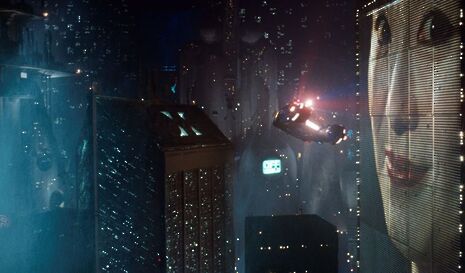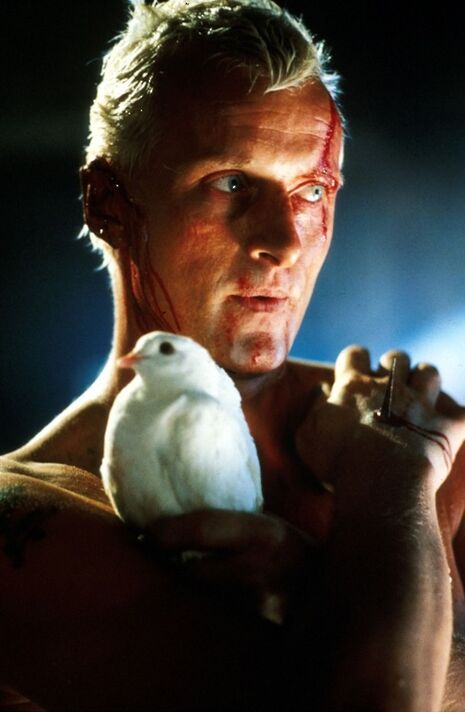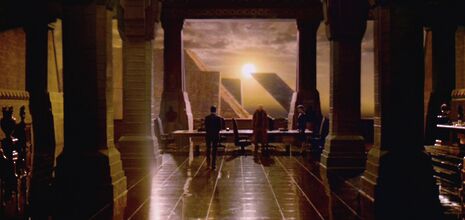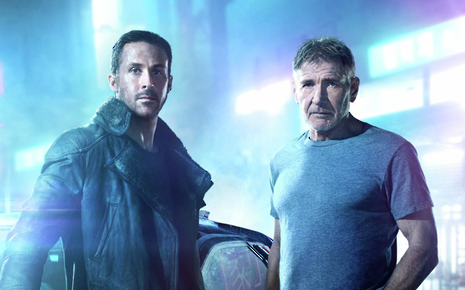Best Sci-Fi: ‘Blade Runner’
With a sequel imminent, Noah Froud ponders over why a film made without CGI 35 years ago remains the most relevant, and Cambridge’s favourite, work of cinematic science fiction

A retired cop is brought out of retirement to hunt down four dangerous fugitives in a bustling metropolis – classic film noir. These are not just any fugitives though, but rather ‘replicants’, artificial copies of humans manufactured by the Tyrell Corporation. Nor is this any old cop. Rick Deckard is a ‘blade runner’, a detective tasked with ‘retiring’ rogue replicants.
What is striking about Blade Runner is the way it has endured both in terms of its influence on other films, and how it has remained an entertaining watch to this day. Key to this is the simple premise at its heart, which has layers of complexity added on top.
“Ultimately, though, the point is not whether Deckard is or is not human. The doubt is merely a tool to explore the blurred line between human and artificial, real and fake.”
It is therefore possible to enjoy Blade Runner at this surface level, with a stoic Harrison Ford as Deckard hunting down each of the replicants in turn through a labyrinthine city. Indeed, that is what theatre audiences originally thought they were getting. The film by no means disappoints in this regard, with a smattering of iconic designs and action scenes. The death of the replicant Zhora as she plunges through a glass shop front, ironically surrounded by artificial mannequins, is particularly noteworthy.
Beneath the staggering urban texture there is something deeper going on. Plot twists are common in all films but in science fiction they tend to become more central, revelations of the highest order. From epic Stanley Kubrick and Christopher Nolan blockbusters like 2001: A Space Odyssey and Interstellar, to low-budget stars like Primer, shocking reveals are integral to making meaningful science fiction.
The reason Blade Runner’s plot is special, the reason for its excellence, is the ambiguity of its great revelation. The fact that Deckard might be a replicant himself is never explicitly confirmed in the film. The indicator, the legendary unicorn dream, did not even feature in the original theatrical release. The uncertainty even extends to those who made the film: director Ridley Scott has indicated that Deckard is a replicant, while Ford and screenwriters disagree. Ultimately, though, the point is not whether Deckard is or is not human. The doubt is merely a tool to explore the blurred line between human and artificial, real and fake.

In the world of Blade Runner, replicants can develop the ability to have an ‘emphatic response’ after a few years. This would mean they could pass as humans in the ‘Voight-Kampff’ test which is apparently capable of distinguishing replicants from real humans. To prevent this, they have an in-built four-year lifespan. But what is the difference between a replicant with developed emotions and a human?
As the film portrays, not very much. Zhora dies desperately trying to escape Deckard, clinging to life as she falls multiple times. Leon is killed trying to avenge her, having witnessed her suffering. Pris dies letting out a blood-curdling screech of agony, so horrific that Deckard shoots her again and again to end her pain. At the close, Roy Batty delivers his poignant terminal monologue about how all his memories “will be lost in time, like tears in the rain.” By comparison, Deckard is a remarkably empty character, all of which adds to melding of natural and artificial. If Deckard is really human, has he not shown himself to be more cold and emotionless than the supposedly artificial ‘skin-jobs’?
Aside from the plot, special mention should go to the film’s design and visuals. The setting is vital to any work of science fiction, and Blade Runner deals with it masterfully. The portrayal of 2019 ‘San Angeles’ is neither simply that of a clean, utopian city-scape, nor a dystopian, overcrowded ruin, but rather an amalgamation of both. A mish-mash of decay and glitzy cinematic billboards, punctuated by floating blimps advertising a better life in the off-world colonies. The action jumps from chaotic street markets and dingy abandoned apartments to upper-class bars and Tyrell’s luxurious, pharaoh-like apartment. The level of detail is astounding, from neon umbrellas apparently all the rage with pedestrians to the clutter in the police offices.
“The ability of the film to convincingly create and portray a fictional world and maintain thematic depth and complexity on the same scale as a book is an indication of the creative genius behind the film.”
Science fiction films tend to age very badly. Their predictions for the future are proven widely inaccurate and their reliance on special effects to portray the future often make them ironically of their time and out of date, both in terms of story and visuals. Yet Blade Runner is relatively immune from this. From the grand sweeping visuals of the city skyline to the design of its computers and dashboards, Blade Runner’s design remains enthralling. Its ability to endure and the achievement this marks is added to when compared to other sci-fi of the era like David Lynch’s Dune which clearly bear the marks of their age.
Additionally, Blade Runner, unlike Scott’s other space-based masterwork, Alien, or the post-apocalyptic wasteland of George Miller’s Mad Max, is trying to portray something far more difficult in the setting of San Angeles. Cities are far busier, more complex and, ultimately, familiar to audiences, which makes them so much harder to make authentic.

It is no coincidence that Syd Mead, the designer behind the city-scape, is credited by Scott as being more sociologist and city planner than visual designer. Blade Runner’s tangible setting gives it a unique and timeless texture unlike anything before or since. So much so that no cinematic vision of urban future created since can avoid it: the city-planet of Coruscant from the Star Wars prequel trilogy blatantly mimics Mead’s designs with its gas flares and fancy skyscrapers for the wealthy towering over the poverty-ridden slums below.
Blade Runner is further notable as the convergence of two of the greatest minds in science fiction, Scott and Philip K. Dick, author of Do Androids Dream of Electric Sheep?, upon which the film is based. The themes which permeate both Dick and Scott’s careers are present in abundance in Blade Runner. Scott’s obsession with the relationship between the creator and created, something integral to Alien prequels, Prometheus and Alien: Covenant, is particularly prominent in the scene in which a replicant confronts his creator, Tyrell. A constant theme, or paranoid obsession, of Dick’s literature is that of reality and ‘realness’. Are the replicants ‘real’ in their humanity? Is Deckard a replicant? By exploring these deeper questions but never arriving at a concrete answer, Blade Runner does what good science fiction should do.
“Its remarkable impact on the genre, combined with its ability to endure and unique elegance in its exploration of deeper themes, marks Blade Runner as a defining film.”
A very rare thing in science fiction is a film which lives up to the book, either in the mind of the author or their fans. I am Legend and I, Robot, starring Will Smith, are probably the most unforgivable examples of such mutilation of literature on screen, but the list of mediocre conversions spans from Paul Verhoeven’s Starship Troopers to Zack Snyder’s Watchmen. Yet with Blade Runner, Dick was not only satisfied but stated his amazement that the film portrayed exactly what he imagined in his head when he was writing.
Helped immeasurably by Vangelis’s moving synth soundtrack, tailored to every expression in every scene, the film perfectly captures the paranoid feel of Dick’s work from the first to the last. The ability of the film to convincingly create and portray a fictional world and maintain thematic depth and complexity on the same scale as a book is an indication of the creative genius behind the film. Other films have been attempted to tackle Dick’s work, but despite receiving positive reviews, they lack the classic originality of Blade Runner.

Its remarkable impact on the genre, combined with its ability to endure and unique elegance in its exploration of deeper themes, marks Blade Runner as a defining film. Achieving all this whilst remaining entertaining to audiences to this day makes it an obvious winner in our survey. The forthcoming sequel, Blade Runner: 2049, will have its work cut out to match up to the original when it is released in October. However, with original writer Hampton Francher retained, alongside Scott as executive producer, it is certainly one to keep an eye on.
A failure on theatrical release, Blade Runner has proven to be, somewhat ironically, future-proof. Since the release of the director’s cut, restoring the bleak nature Scott originally intended, it has earned its place as a monument in film history, and an enviable cult status through giving audiences more questions and doubts with each viewing
 Comment / The (Dys)functions of student politics at Cambridge19 January 2026
Comment / The (Dys)functions of student politics at Cambridge19 January 2026 News / Local business in trademark battle with Uni over use of ‘Cambridge’17 January 2026
News / Local business in trademark battle with Uni over use of ‘Cambridge’17 January 2026 Arts / Exploring Cambridge’s modernist architecture20 January 2026
Arts / Exploring Cambridge’s modernist architecture20 January 2026 Features / Exploring Cambridge’s past, present, and future18 January 2026
Features / Exploring Cambridge’s past, present, and future18 January 2026 News / Your Party protesters rally against US action in Venezuela19 January 2026
News / Your Party protesters rally against US action in Venezuela19 January 2026







